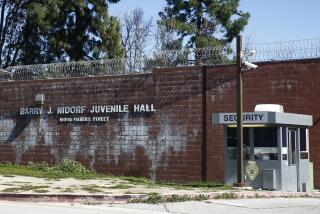Program Targets Guns in Hands of Felons on Probation
- Share via
Although crime rates are the lowest in decades, gun violence remains one of the highest public safety concerns. Tragic stories of random shootings at schools, churches and workplaces appear in the news almost daily.
Ninety-three people die every day from gunshot wounds and another 240 sustain gunshot injuries nationwide. Something must be done to stop these senseless shootings.
In California, creating new laws on top of the 675 existing gun control laws isn’t the answer. Rather, we need to aggressively enforce these laws and work harder to take guns out of the hands of criminals.
Los Angeles County has been a leader in developing innovative programs to seize guns and other weapons from convicted felons on probation. Recently, the Board of Supervisors approved the county Probation Department’s request to fund and implement a pilot project called DISARM (Developing Increased Safety Through Arms Reduction). Through this program, the Probation Department, local prosecutors and law enforcement team up to aggressively enforce conditions of probation. Convicted criminals are placed on probation in lieu of prison, with certain conditions placed on them. These conditions often include weapons prohibitions and being subjected to warrantless searches. DISARM focuses on high-risk probationers prohibited from possessing any weapons. Since the program’s inception in February, 116 targeted searches have been conducted in Los Angeles, confiscating 45 weapons with a total of 57 arrests for probation violations.
*
DISARM’s success in Los Angeles County has led the Probation Department to seek legislation to expand the project statewide. As a result, I authored Assembly Bill 2437 to create a statewide DISARM program that would provide $50 million in grant money to counties that choose to participate. The money would be allocated to county probation departments to conduct frequent search and seizure raids on probationers. As in Los Angeles County, only high-risk offenders, convicted at least once of robbery or possession of an illegal firearm or other weapon, would be targeted. This means that 7,000 to 9,000 of Los Angeles County’s 90,000 probationers would be subject to more aggressive enforcement.
Probation officers are generally responsible for the supervision of offenders who have been released into the community as an alternative to incarceration. However, in previous years, California counties were forced to reduce probation services in response to growing budgetary shortfalls. At the same time, an increase in the backlog of sentenced felons placed pressure on local courts and county jails to increase probation referrals. This has resulted in county probation officials managing larger caseloads with fewer resources. In Los Angeles County, for example, the ratio of probationers to probation officers is reaching 1,000 to one.
Overwhelming caseloads often result in probationers receiving little or no supervision, placing many citizens at risk. Research has shown that probationers often reoffend. A report released last year by the Center for Civic Innovation at the Manhattan Institute, a nonprofit think tank in New York, estimated that about two-thirds of probationers commit another crime within three years of their sentence. The study found that the roughly 162,000 probationers returned to state prisons and incarcerated in 1991 were responsible for at least 6,400 murders, 7,400 rapes, 10,400 assaults and 17,000 robberies.
*
The state is providing law enforcement with few resources to monitor an overwhelming number of probationers. New gun laws won’t solve this problem, and many statewide law enforcement associations have publicly asked for a freeze on new gun control laws. New laws would only create more bureaucracy, adding more pressure on California’s public safety officials. Providing law enforcement with more resources to adequately enforce existing laws is the most effective solution.
In light of California’s $12-billion budget surplus, $50 million to be divided among the 58 counties is practically pocket change. The safety of our communities is priceless--and so is a solution to gun violence.
More to Read
Sign up for Essential California
The most important California stories and recommendations in your inbox every morning.
You may occasionally receive promotional content from the Los Angeles Times.













